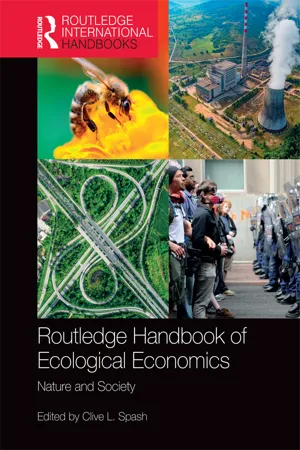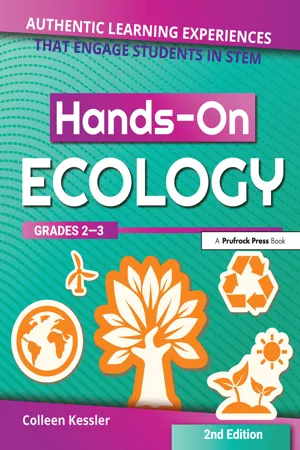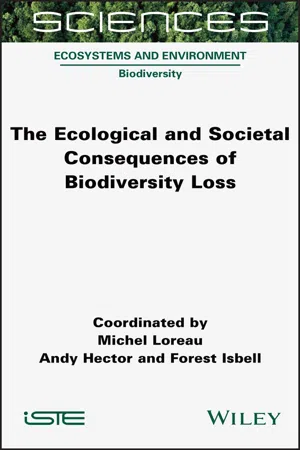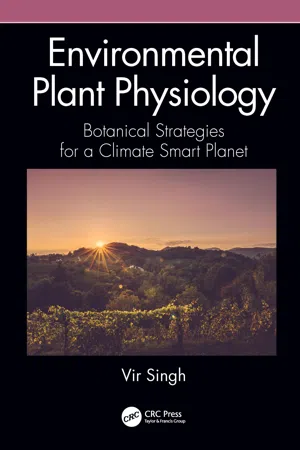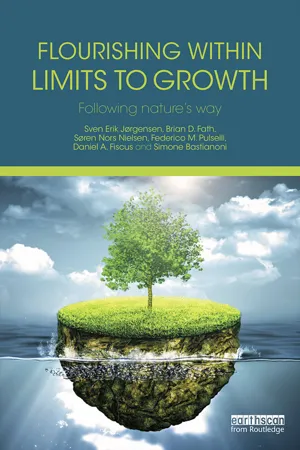Ecosystems
Ecosystems are complex networks of living organisms, their physical environment, and the interactions between them. They encompass a wide range of habitats, from forests and oceans to deserts and grasslands. Ecosystems play a crucial role in maintaining ecological balance, providing essential services such as nutrient cycling, water purification, and habitat for diverse species.
7 Key excerpts on "Ecosystems"
- eBook - ePub
Routledge Handbook of Ecological Economics
Nature and Society
- Clive L. Spash, Clive L. Spash(Authors)
- 2017(Publication Date)
- Routledge(Publisher)
...Several approaches have been proposed; for example, studying ecosystem energy flows and cycling of materials, leading to description of the distribution of key elements (e.g., carbon, phosphorus, or nitrogenous) within and between living and non-living forms, and the balance between energy entrance and dissipation. Another alternative is to focus on how the diversity and composition of living forms contribute to ecosystem functioning defined through specific variables such as biomass production or specific properties such as resilience or resistance. Changes in approach have involved redefinitions and critiques of the ecosystem concept that have forged the history of ecology (Golley, 1993). However, two elements can be considered as stable focal points of interest in any ecological perspective. First, ecologists recognise Ecosystems as designating the interactions between living and non-living forms. An ecosystem is therefore neither an organism nor a collection of organisms but a combination of biotic and abiotic entities. Second, ecologists adopt a criterion to delineate specific spatial and temporal extents in which these interactions occur. The spatial and temporal scales of Ecosystems are not specified a priori but rather depend on the organisms and processes of interest. In other words, defining Ecosystems corresponds to the delineation of specific interactions which can vary from a few centimetres to hundreds of kilometres. A general definition of Ecosystems is therefore: the ensemble of conditions allowing the interactions between biotic and abiotic elements in a given space and time. As such, any ecosystem is an open system linked to other Ecosystems. Once delineated, a given ecosystem is characterised by its structure (describing how the different living and non-living forms interact) and its processes (the consequences of these interactions on the properties of the system)...
- eBook - ePub
- Oswald J. Schmitz(Author)
- 2013(Publication Date)
- Island Press(Publisher)
...Natural ecological systems differ from the container system in that they are comprised of vastly more species with many more interdependencies than those found in the glass container. Understanding these complex interdependencies is the fundamental purpose of that subfield of biology known as ecology. What Is Ecology? Ecology is a science aimed at understanding: The processes by which living organisms interact with each other and with the physical and chemical components of their surrounding environment. The way those processes lead to patterns in the geographical distribution and abundance of different kinds of organisms. The result of the process leading to a pattern is the assembly of a natural economy. In ecology such a natural economy is formally called an ecosystem. Ecosystems encapsulate many forms of biological diversity (also called biodiversity). Biodiversity results from a variety among individuals comprising a species owing to sex, age, and genetic differences among those individuals. It also stems from differences between species living together in a geographic location. For example, species may differ in their functional roles (e.g., plant, herbivore, carnivore) and the efficiency with which each carries out its function in different environmental conditions. Biodiversity also arises from the myriad ways that species are linked to each other in Ecosystems. As a consequence of these many forms of biodiversity, there is considerable complexity underlying the structure of Ecosystems.The challenge in ecology is resolving this complexity. Biodiversity results from a variety among individuals comprising a species due to sex, age, and ge- netic differences; from differences between species living together in a geographic location; and from the myriad ways that species are linked to each other in Ecosystems. As a consequence of these many forms of biodiversity, there is consider- able complexity underlying the structure of Ecosystems...
- eBook - ePub
Hands-On Ecology
Authentic Learning Experiences That Engage Students in STEM (Grades 2-3)
- Colleen Kessler(Author)
- 2021(Publication Date)
- Routledge(Publisher)
...CHAPTER 2 WHAT IS AN ECOSYSTEM? DOI: 10.4324/9781003235446-3 Defining the Term In 1935, the British Botanist Arthur Tansley created the term ecosystem to describe the communities of organisms interacting with one another. During the late 1800s and early 1900s, he was instrumental in leading the movement toward conservationism by using sampling methods to study ecological patterns and to facilitate understanding of the impact humans have on their environment. Understanding what makes an ecosystem and what role humans play in their ecosystem is essential to a study of ecological science. An ecosystem is made up of living things interacting with one another and the nonliving things within their habitat. Their composition and structure can be defined by several environmental factors, like nutrient availability, water sources, plant growth and life, and temperature. Anytime changes occur in these factors, the structure of the ecosystem is affected. For example, a forest fire flattens and kills life in an area once populated with old, large trees. Mosses, shrubs, and other organisms are killed, and their nutrients are released into the atmosphere. After a time, a new ecosystem of grasses and seedlings replaces the formerly well-established forest area. Ecosystems vary in size—they can be as large as an ocean (and bigger), or as small a tide pool. A tree, the muddy area beneath a rock, and the planet Earth—these are all separate, but interconnected, Ecosystems. Interdependence Organisms depend on their Ecosystems for survival. The community in which they live provides everything they require for survival. Food, water, shelter, light, protection, and nutrients are all necessary for an organism to thrive...
- Michel Loreau, Andy Hector, Forest Isbell(Authors)
- 2022(Publication Date)
- Wiley-ISTE(Publisher)
...Introduction The Ecological and Societal Consequences of Biodiversity Loss Michel LOREAU 1, Andy HECTOR 2, and Forest ISBELL 3 1 Theoretical and Experimental Ecology Station, CNRS, Moulis, France 2 University of Oxford, UK 3 University of Minnesota, St. Paul, USA One of the distinctive and fascinating features of ecological systems is their extraordinary complexity. An ecosystem is often composed of thousands of different species that interact in myriad ways at the scale of a single hectare. Each species is composed of many individuals that vary due to differences in their genetics and their particular experience of their local environment. These complex local systems are strongly connected to each other, and aggregate into larger and larger entities, from the landscape scale to that of the entire biosphere, where it becomes evident that they exert a major influence on the physical and chemical properties of our planet. How can such enormously complex systems be studied? During the second half of the 20th century, two increasingly divergent approaches to ecological systems developed within ecology, which have gradually led to two largely distinct disciplines, community ecology and ecosystem ecology. A community is defined broadly as a set of species that live together in some place. The focus in community ecology has traditionally been on species diversity: what exogenous and endogenous forces lead to more or less diverse communities? How do species interactions constrain the number of species that can coexist? What patterns emerge from these interactions? An ecosystem is the entire system of biotic and abiotic components that interact in some place. The ecosystem concept is broader than the community concept because it includes a wide range of biological, physical, and chemical processes that connect organisms and their environment...
- eBook - ePub
Environmental Plant Physiology
Botanical Strategies for a Climate Smart Planet
- Vir Singh(Author)
- 2020(Publication Date)
- CRC Press(Publisher)
...The biosphere is never in a static state. It is charged with the power of natural evolution. Hierarchical life, systems, and orders are all the spectacular outcomes of an unceasing evolution. Biodiversity, also a splendid feat of natural evolution, is organized into ecological groupings, such as populations of different species and communities. Biodiversity of life at every level comprises the richness of life and sum total of this richness and the factors and phenomena upholding, evolving, and sustaining the richness of life constitute the biosphere. THE ORGANISM-ENVIRONMENT RELATIONSHIPS An organism constitutes the smallest level of ecological hierarchy. It may be unicellular or multicellular in its structure but is an “autonomous” unit of the environment capable of performing its own functions. An organism, however, is not an independent entity. For its existence, sustenance and other essential activities, it depends on several other organisms directly and indirectly. All the organisms on planet Earth constitute a biotic component of the environment. They all are in continuous interaction with their physical environment (abiotic component of the environment). There is continuous exchange of materials between the organisms and their physical or abiotic environment. They derive energy, nutrients, water, and oxygen from the environment, which is indispensable for their maintenance, growth, and reproduction. They return to their environment whatever is over and above their maintenance, growth, and reproductive functions. These include the heat and solid, liquid, and gaseous wastes generated through metabolism. The environment is an integrated whole. The abiotic and biotic components are woven into each other and are inseparable from each other. The quality of the physical environment has implications on the living organisms. And the living organisms have bearing on the quality of the physical environment. The two are in a reciprocal relationship...
- eBook - ePub
Human Ecology
Basic Concepts for Sustainable Development
- Gerald G Marten(Author)
- 2010(Publication Date)
- Routledge(Publisher)
...4 Ecosystems and Social Systems as Complex Adaptive Systems Ecosystems and social systems are complex adaptive systems : complex because they have many parts and many connections between the parts; adaptive because their feedback structure gives them the ability to change in ways that promote survival in a fluctuating environment. How can we understand human–ecosystem interaction when social systems and Ecosystems are so overwhelmingly complex? The answer lies in emergent properties : the distinctive features and behaviour that ‘emerge’ from the way that complex adaptive systems are organized. Once aware of emergent properties, it is easier to ‘see’ what is really happening. Emergent properties are cornerstones for comprehending human–ecosystem interactions in ways that provide insights for sustainable development. This chapter will begin by explaining the concept of emergent properties. It will then describe three significant examples of emergent properties in detail: Self-organization. Stability domains. Complex system cycles. Later chapters will describe additional emergent properties of Ecosystems and social systems. Hierarchical Organization And Emergent Properties Biological systems have a hierarchy of organizational levels that extends from molecules and cells to individual organisms, populations and Ecosystems. Every individual plant and animal is a collection of cells; every population is a collection of individual organisms of the same species; and every ecosystem consists of populations of different species. The most important levels of biological organization for human ecology are populations and Ecosystems. Each level of biological organization from molecules to Ecosystems has characteristic behaviours which emerge at that level. These distinct behaviours, called emergent properties, function synergistically at each level of organization to give that level a life of its own which is greater than the sum of its parts...
- eBook - ePub
Flourishing Within Limits to Growth
Following nature's way
- Sven Erik Jørgensen, Brian D. Fath, Søren Nors Nielsen, Federico M. Pulselli, Daniel A. Fiscus, Simone Bastianoni(Authors)
- 2015(Publication Date)
- Routledge(Publisher)
...A lion kills only one zebra, which is sufficient for the pride to be satisfied in that instance in time – also because it is hard work (energetically costly) to kill a zebra. It is not possible for the lion to accumulate dead zebra, which would spoil, or to trade the extra zebra for currencies that do not spoil for use at a later time. The lion and zebra must live in the present. Humans have developed ways to store resource flows by harvesting all the “zebra”; capital can be accumulated in a currency that does not spoil (it may lose value due to inflation, but that is a different matter). In this manner, humans continue to accumulate money beyond their needs, which is used to further exploit limited resources. The structure of our society today makes this possible, and a shift is therefore needed for a better cooperation among humans and a fairer distribution of the work energy, which would enable society to flourish, mainly by increasing the network integration and level of information. 3.10 Ecosystems are organized hierarchically A cell may contain one billion molecules, and an organism contains from one to about 10,000 billion cells. Hundreds or thousands of organisms form a population, and an ecosystem may support life for hundreds or thousands of populations. Ten or maybe 1,000 Ecosystems make up a landscape, and a region may encompass many landscapes. The entire life-bearing part of the Earth is denoted the ecosphere. All the parts and processes in one level are integrated to make a sound and healthy system on the next level. A system is both a whole at one level made up of smaller scales as well as part of a larger system at a higher scale. There is an interplay and feedback of control over lower levels and support up to higher levels. For instance, organisms control their cells by exchanging biochemical components among the cells and provide the cells with the needed energy originated from animal biomass and ultimately solar radiation...
